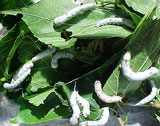|

Silk is beautiful, highly-desirable and pricey. Do you know how it is produced?
Silkworms are the offspring ofmoths. They spew out thread from tiny holes in their jaws, which they use to spin into theiregg-bearingcocoons. This entire production takes a mere 72 hours, during which time they produce between 500-1200silkenthreads. These miniature,mulberryleaf-munchingmarvelslay, at minimum, 500 eggs each spring, thereby increasing the number of workers for the production line.
The ancient Chineseunearthedthe silkworm's secret, and were the first to spin the silkworm's threads into cloth. They kept thiscovert, top-secret operation, from the rest of the world by imposing the death sentence upon those who smuggled the worm or its eggs out of China. Eventually, however, the secret was out, and silkworms are nowfarmedfor their silk, in China, of course, in Japan, in India, in France, in Spain, and in Italy. These countries harness the power of the silkworm through a tedious, labor-intensive, time-consuming process, a process which prominently figures into the price of silk.
Farm workerspainstakinglyplace the 500 plus eggs thegrayish-whitemoth lays, upon strips of paper or cloth, until the following spring, when the incubated eggs hatch, and the tiny, black worms emerge. Once hatched, workers transport the worms to trays brimming with the worm's favoritefodderof finely chopped, white mulberry leaves. After approximately 6 weeks, the satiated worms begin slowly to sway their heads back and forth to signal that show time isat hand.
Once the silkworm completes its cocoon, the farmer snatches his cocoon from him, to prevent theshrunken chrysalis, carefully encased inside, from hatching into a moth in 12 days. The silk farmers ensure that this event does nottranspire, and does not kill his moneymaking venture, by exposing the cocoons to heat, thereby executing the chrysalis. Now, the silkworm's labor of love is prepared for the silk production process.
The process begins by bathing the now-empty cocoons in troughs of warm water, which serves to soften the gum binding the silkenfilamentstogether. He now proceeds with the arduous task of unraveling several cocoons, and winding the filaments onto areelthat twists 10-12 filaments together into a "single" thread of silk. The end product is a skein ofraw silk, which the farmer profits from by selling to the highest bidder.
|
|
note:
|
pricey: 昂貴的
moth: 蛾
egg-bearing cocoon: 雞蛋狀的蠶繭
silken: 柔軟光亮的
mulberry: 桑樹
unearth: 發(fā)現(xiàn)
covert: 秘密的
farm: 飼養(yǎng)
painstakingly: 辛苦地
grayish-white: 灰白色
fodder: 飼料
at hand: 即將到來
shrunken: 縮小的
chrysalis: 繭
transpire: 發(fā)生
filament: 絲
reel: 卷軸
raw silk: 生絲
|
|